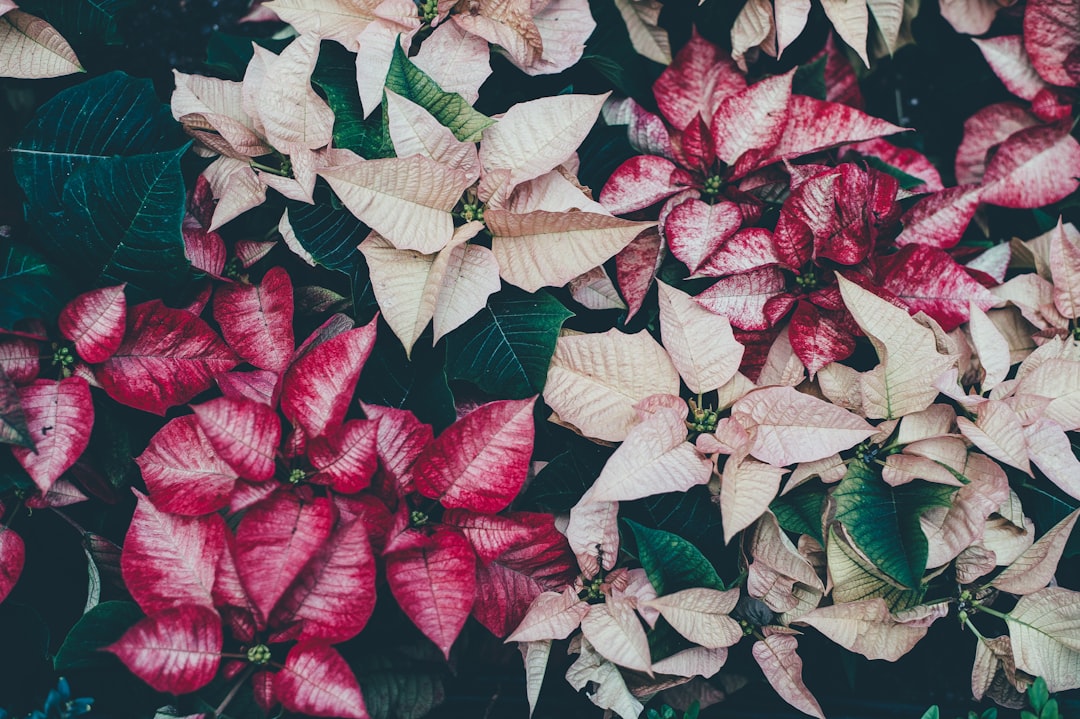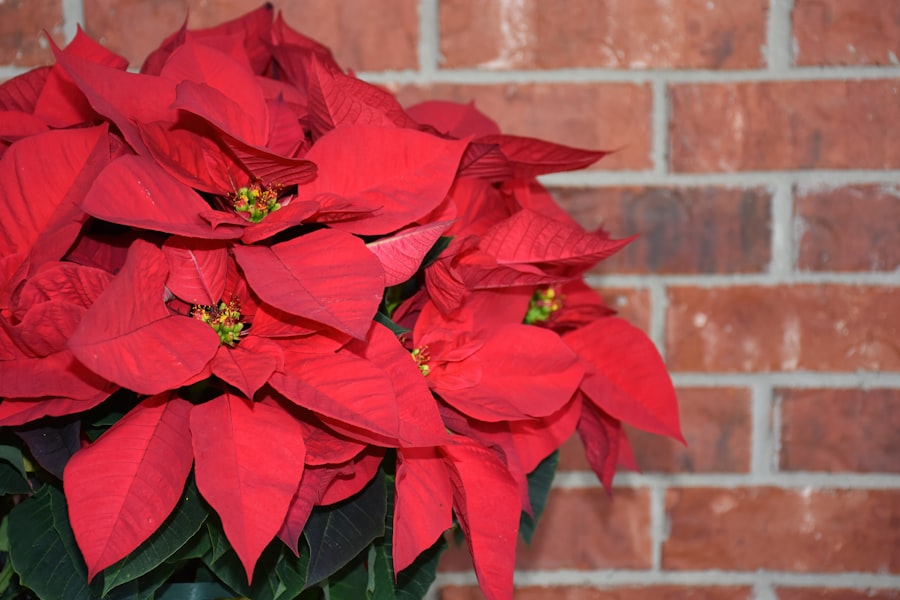Watering Poinsettias: How Often is Enough?

Poinsettias are popular plants that are often associated with the holiday season. These vibrant plants, with their bright red, white, or pink bracts, add a festive touch to any home or office. Poinsettias have a rich history that dates back to ancient times. They were first cultivated by the Aztecs in Mexico and were later introduced to the United States by Joel Poinsett, the first U.S. ambassador to Mexico, in the early 19th century.
Proper watering is essential for the health and longevity of poinsettias. These plants have specific watering needs that must be met in order for them to thrive. Overwatering or underwatering can lead to a variety of problems, including root rot, wilting, and leaf drop. In order to keep your poinsettias looking their best, it is important to understand the importance of proper watering.
Key Takeaways
- Poinsettias require proper watering to thrive
- Factors such as temperature, humidity, and pot size affect watering frequency
- Overwatering can lead to root rot, while underwatering can cause wilting
- Water poinsettias thoroughly and allow soil to dry slightly before watering again
- Avoid common mistakes such as using cold water or letting plants sit in standing water
Understanding the Importance of Proper Watering for Poinsettias
Water plays a crucial role in the growth and development of poinsettias. It is necessary for nutrient uptake, photosynthesis, and overall plant health. Without adequate water, poinsettias will not be able to grow properly and may become weak and susceptible to disease.
Overwatering can be just as detrimental to poinsettias as underwatering. When poinsettias are overwatered, their roots become waterlogged and are unable to take in oxygen. This can lead to root rot and other fungal diseases. Overwatered poinsettias may also develop yellow or brown leaves and may wilt or droop.
On the other hand, underwatering can cause poinsettias to become dehydrated and wilt. This can lead to leaf drop and stunted growth. It is important to find the right balance when watering poinsettias in order to avoid these problems.
Factors That Affect Poinsettia Watering Frequency
Several factors can affect the watering frequency of poinsettias. Environmental factors such as temperature, humidity, and light can all impact how quickly poinsettias dry out and therefore how often they need to be watered.
Poinsettias prefer temperatures between 60 and 70 degrees Fahrenheit during the day and slightly cooler temperatures at night. Higher temperatures can cause the soil to dry out more quickly, while lower temperatures can slow down the drying process. Humidity levels also play a role in how quickly poinsettias dry out. Higher humidity levels can slow down evaporation, while lower humidity levels can speed it up.
The type of soil and its drainage capabilities can also affect how often poinsettias need to be watered. Poinsettias prefer well-draining soil that allows excess water to flow out of the pot. If the soil retains too much moisture, it can lead to root rot and other problems.
The size and material of the pot can also impact watering frequency. Smaller pots will dry out more quickly than larger pots, so they may need to be watered more often. Pots made of porous materials such as clay will also dry out more quickly than pots made of plastic or metal.
Signs of Overwatering and Underwatering in Poinsettias
| Signs of Overwatering | Signs of Underwatering |
|---|---|
| Yellowing leaves | Wilting leaves |
| Mushy or rotten roots | Dry soil |
| Fungus or mold growth | Brittle or crispy leaves |
| Slow growth or stunted growth | Leaf drop |
| Root rot | Leaf curling |
It is important to be able to recognize the signs of overwatering and underwatering in poinsettias in order to adjust your watering practices accordingly.
One of the most common signs of overwatering is wilting or drooping leaves. When poinsettias are overwatered, their roots become waterlogged and are unable to take up oxygen. This causes the leaves to wilt and droop.
Yellowing or browning of leaves can also be a sign of overwatering or underwatering. Overwatered poinsettias may develop yellow or brown leaves due to root rot, while underwatered poinsettias may develop yellow or brown leaves due to dehydration.
Root rot or mold growth is another sign of overwatering. When poinsettias are overwatered, the excess moisture can lead to root rot and the growth of mold or fungus. This can cause the roots to become mushy and black.
Tips for Watering Poinsettias in Different Environments
The watering needs of poinsettias can vary depending on whether they are grown indoors or outdoors.
In indoor environments such as homes, offices, or greenhouses, it is important to monitor the temperature and humidity levels. Poinsettias grown indoors may require more frequent watering due to the lower humidity levels typically found indoors. It is also important to place poinsettias in a location that receives bright, indirect light. This will help them dry out more quickly and prevent overwatering.
In outdoor environments such as patios or gardens, it is important to consider the temperature and rainfall patterns. Poinsettias grown outdoors may require less frequent watering if they receive adequate rainfall. However, it is still important to monitor the soil moisture levels and adjust watering practices accordingly.
Best Practices for Watering Poinsettias in Containers

When growing poinsettias in containers, it is important to choose the right container and soil, water them at the correct frequency and amount, and ensure proper drainage.
Choose a container that has drainage holes in the bottom to allow excess water to flow out. This will help prevent water from pooling at the bottom of the pot and causing root rot. Use a well-draining potting mix that is specifically formulated for potted plants.
Water poinsettias when the top inch of soil feels dry to the touch. This will help prevent overwatering while ensuring that the plants receive adequate moisture. Water thoroughly until water flows out of the drainage holes in the bottom of the pot.
To ensure proper drainage, place a saucer or tray under the pot to catch any excess water. Empty the saucer or tray after watering to prevent the roots from sitting in standing water.
Watering Poinsettias in Outdoor Landscapes
When growing poinsettias in outdoor landscapes, it is important to prepare the soil and ensure proper drainage, mulch to retain moisture, and adjust watering frequency based on weather conditions.
Before planting poinsettias in the ground, prepare the soil by adding organic matter such as compost or peat moss. This will help improve soil drainage and fertility. Ensure that the planting area has good drainage to prevent water from pooling around the roots.
Mulching around poinsettias can help retain moisture in the soil and reduce evaporation. Apply a layer of organic mulch such as wood chips or straw around the base of the plants, taking care not to cover the stems or leaves.
Adjust watering frequency based on weather conditions. Poinsettias may require more frequent watering during hot, dry periods and less frequent watering during cool, rainy periods. Monitor the soil moisture levels and adjust watering practices accordingly.
Watering Poinsettias During Different Stages of Growth
The watering needs of poinsettias can vary depending on their stage of growth.
During the early growth and establishment stage, poinsettias require more frequent watering to encourage root development. Water them when the top inch of soil feels dry to the touch, taking care not to overwater.
During the flowering and bract development stage, poinsettias may require less frequent watering. Monitor the soil moisture levels and adjust watering practices accordingly. Be careful not to overwater during this stage, as it can lead to root rot and other problems.
After the poinsettias have finished flowering and enter the post-flowering and dormancy stage, reduce watering to allow the plants to rest. Water them sparingly, allowing the soil to dry out slightly between waterings.
Common Mistakes to Avoid When Watering Poinsettias
There are several common mistakes that should be avoided when watering poinsettias.
One of the most common mistakes is overwatering or underwatering. It is important to find the right balance when watering poinsettias in order to avoid problems such as root rot or dehydration. Monitor the soil moisture levels and adjust watering practices accordingly.
Another common mistake is watering at the wrong time of day. It is best to water poinsettias in the morning or early afternoon, allowing enough time for the foliage to dry before nightfall. Watering in the evening can increase the risk of fungal diseases.
Using tap water with high levels of chlorine or fluoride can also be detrimental to poinsettias. These chemicals can build up in the soil over time and cause damage to the roots. If your tap water has high levels of chlorine or fluoride, consider using filtered or distilled water instead.
Achieving Optimal Watering Balance for Healthy Poinsettias
In conclusion, proper watering is essential for the health and longevity of poinsettias. Understanding the importance of proper watering and recognizing the signs of overwatering and underwatering can help you adjust your watering practices accordingly.
Factors such as temperature, humidity, light, soil type, pot size, and material can all affect how often poinsettias need to be watered. It is important to monitor these factors and adjust watering practices accordingly.
By following best practices for watering poinsettias in containers and outdoor landscapes, you can help ensure that your plants receive adequate moisture without becoming waterlogged. Avoid common mistakes such as overwatering or underwatering, watering at the wrong time of day, and using tap water with high levels of chlorine or fluoride.
By achieving the optimal watering balance, you can help your poinsettias stay healthy and vibrant throughout the holiday season and beyond. With proper care and attention, these beautiful plants can bring joy and beauty to your home or office for years to come.
If you’re wondering how often poinsettias need to be watered, you’ll find some helpful insights in this article from Lawn World. They provide expert advice on caring for these vibrant holiday plants, including watering tips and guidelines. To learn more about maintaining the health and beauty of your poinsettias, check out this informative resource on Lawn World. You can also explore their sitemap for a comprehensive overview of their gardening articles and resources.
FAQs
What is a poinsettia?
A poinsettia is a popular holiday plant with bright red, pink, or white leaves that are often mistaken for flowers. It is native to Mexico and Central America and is also known as the Christmas flower.
How often should I water my poinsettia?
Poinsettias should be watered when the soil feels dry to the touch. Overwatering can cause root rot, so it’s important not to let the plant sit in standing water. It’s generally recommended to water poinsettias once a week.
Can I overwater my poinsettia?
Yes, overwatering can cause root rot and other problems for poinsettias. It’s important to let the soil dry out between waterings and not to let the plant sit in standing water.
What kind of soil is best for poinsettias?
Poinsettias prefer well-draining soil that is rich in organic matter. A soil mix that is specifically formulated for poinsettias or other holiday plants is a good choice.
Do poinsettias need fertilizer?
Yes, poinsettias benefit from regular fertilization during the growing season. A balanced fertilizer with equal amounts of nitrogen, phosphorus, and potassium is a good choice.
Can poinsettias be grown outdoors?
Poinsettias are tropical plants and are not frost-tolerant, so they are typically grown as indoor plants in colder climates. However, they can be grown outdoors in warm, humid climates with mild winters.



